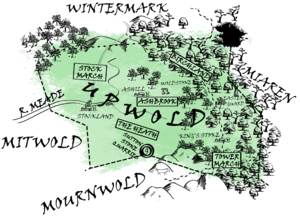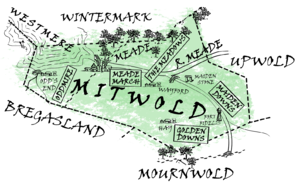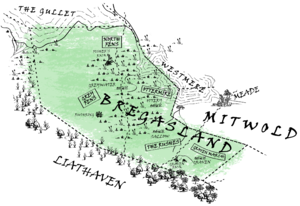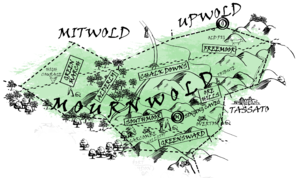The Marches territories
| Line 14: | Line 14: | ||
==[[Bregasland]] the Dour Fens== | ==[[Bregasland]] the Dour Fens== | ||
Sandwiched between the | Sandwiched between the dark woods of [[Liathaven]], the southern [[Jotun]] kingdoms, and the sea, lies Bregasland. The territory is primarily made up of freshwater fenland. Home to “Bregas” (fenlanders), this is a place of small islands of abundantly fertile soil, surrounded by seemingly endless marshes where eels are caught. There are several households here made up entirely of [[merrow]], and several settlements populated by people who have been shunned but cannot bring themselves to leave the Marches. | ||
Bregasland is home to partially sunken ruins, including several stone circles that pre-date Marcher possession of the land. For some reason the marshwalkers that are comparatively common in the marshes tend to leave these ruined structures alone. It is also home to dangerous man-eating lizards, giant insects, flesh-eating plants, bottomless bogs and strange lights that seek to lure the incautious into deadly situations. Those who explore the depths of the marshes here sometimes disappear without trace ... | Bregasland is home to partially sunken ruins, including several stone circles that pre-date Marcher possession of the land. For some reason the marshwalkers that are comparatively common in the marshes tend to leave these ruined structures alone. It is also home to dangerous man-eating lizards, giant insects, flesh-eating plants, bottomless bogs and strange lights that seek to lure the incautious into deadly situations. Those who explore the depths of the marshes here sometimes disappear without trace ... | ||
{{CaptionedImage|file=RegionsofMournwold.png|align=right|width=300|link=Mournwold}} | {{CaptionedImage|file=RegionsofMournwold.png|align=right|width=300|link=Mournwold}} | ||
==[[Mournwold]], the Mourn== | ==[[Mournwold]], the Mourn== | ||
This desolate land was known as the Mourn even before its final fall to the barbarian hordes in 349AE. Originally the name referred to the sound of the wind in the trees and across the craggy hills. Now it seems a more fitting name for the loss which Marcher folk feels at the March's passing. The conquest of Mournwold is fresh in the hearts and memories of many Marchers. | This desolate land was known as the Mourn even before its final fall to the barbarian hordes in 349AE. Originally the name referred to the sound of the wind in the trees and across the craggy hills. Now it seems a more fitting name for the loss which Marcher folk feels at the March's passing. The conquest of Mournwold is fresh in the hearts and memories of many Marchers. | ||
Revision as of 13:55, 29 September 2017
Overview
The Marches lie in the western Empire. Mitwold and Upwold are largely made up of fertile farmland, while Bregasland is rich fenland and the Mournwold is a combination of wide grasslands and rolling hills. The territories are covered in a patchwork of farms, small villages, household estates, and the occasional small town. While much of the Marches is civilised, there are still plenty of wild lands - deep forests, lonely hills, and dour marshes alike can harbour greedy brigands, savage orcs, lost ruins, and hungry monsters.
Upwold, The Silver Chase
Upwold is where the Marchers first established themselves when they walked away from Dawn. The scattered orc tribes that dwelt here were no match for the Marcher determination to carve out a home for themselves and were swiftly driven out or defeated. Today, Upwold is a wealthy territory in a wealthy nation, although perhaps surprisingly a significant amount of its wealth comes from industries other than farming. While there are of course many farms in Upwold, the eastern forests of quick-growing silver birch trees provde a great deal of income. Charcoal-burners live there, turning wood into easily transportable fuel for smith and hearth alike while the birch bark is used in the tanning industry, to cure the hides of the cattle that graze on the river pastures.
The forests of Upwold also create a need for skilled beaters - the woodlands are deep and the Feni that make their homes there do not welcome trespassers. For the most part, the painted savages keep to themselves but every few years there is an incidence of raiding, or an attack on a lumber camp or charcoal burner village that they decide has strayed too far into "their" woods.
Mitwold, Pride of the Marches
More than in Upwold or Bregasland, the households of Mitwold engage in feuding and bitter rivalry. The closer two households are to one another in Mitwold, the more likely it is that they are engaged in a long-running feud. This is also the territory where many of the best known ball games are played, and it is a regular occurrence for some dispute to be settled by a savage game of rugby, football or rounders. Outside observers wryly observe that this enthusiasm for sports arises directly from the simmering resentment between the houses - or as often as not is part of the cause.
Mitwold's substantial coast, populated by small fishing villages along the shore, gives way to fertile chalk-soiled downs further inland, with rich game-filled woodland and larger farms and market towns beyond. The city of Meade stands on the western coast of Mitwold - the largest settlement in the Marches, and in some ways its spiritual heart.
Bregasland the Dour Fens
Sandwiched between the dark woods of Liathaven, the southern Jotun kingdoms, and the sea, lies Bregasland. The territory is primarily made up of freshwater fenland. Home to “Bregas” (fenlanders), this is a place of small islands of abundantly fertile soil, surrounded by seemingly endless marshes where eels are caught. There are several households here made up entirely of merrow, and several settlements populated by people who have been shunned but cannot bring themselves to leave the Marches.
Bregasland is home to partially sunken ruins, including several stone circles that pre-date Marcher possession of the land. For some reason the marshwalkers that are comparatively common in the marshes tend to leave these ruined structures alone. It is also home to dangerous man-eating lizards, giant insects, flesh-eating plants, bottomless bogs and strange lights that seek to lure the incautious into deadly situations. Those who explore the depths of the marshes here sometimes disappear without trace ...
Mournwold, the Mourn
This desolate land was known as the Mourn even before its final fall to the barbarian hordes in 349AE. Originally the name referred to the sound of the wind in the trees and across the craggy hills. Now it seems a more fitting name for the loss which Marcher folk feels at the March's passing. The conquest of Mournwold is fresh in the hearts and memories of many Marchers.
Whereas Upwold and Mitwold in particular are known for their sprawling farms, the rugged terrain of the Mourn is perhaps better known for its mines. The hills are riddled with rich veins of green iron, and with mine workings dedicated to extracting that ore. Prior to the invasion of the Jotun, there had been a growing tide of dissatisfaction among professional miners that all political power had been vested in the hands of those who owned farms. There were regular complaints that mine owners, like farmers and stewards, owned and worked land - the only difference was that the crops they raised was ore and stone rather than fruit, grain or vegetables. Most likely this dissatisfaction had its roots in certain sharp business practices by some of the lowland stewards, who set the prices for the food sold to the miners.



